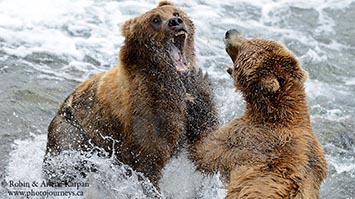
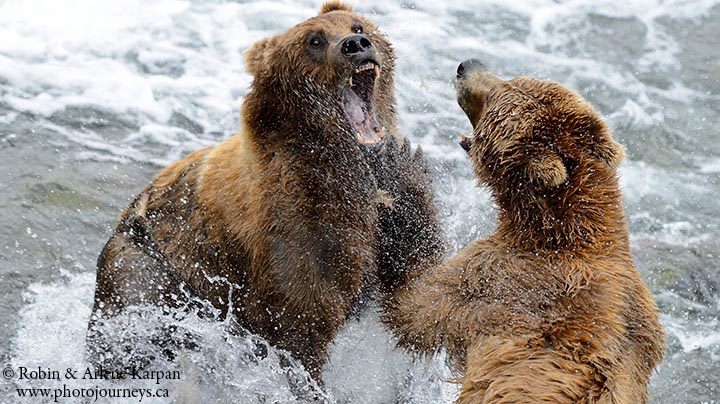
On the last posting we talked about the incredible opportunity to photograph brown bears fishing for salmon, and getting into some wild scuffles, at Alaska’s Brooks River Falls. The falls are located in remote Katmai National Park, accessible only by air. Remoteness, combined with a short season, limited visitor capacity, and high demand, suggests that this is either a difficult place to get to, or is very expensive – or both. It can definitely be expensive, but surprisingly, you can also visit fairly easily and quite economically if you do some careful advance planning.
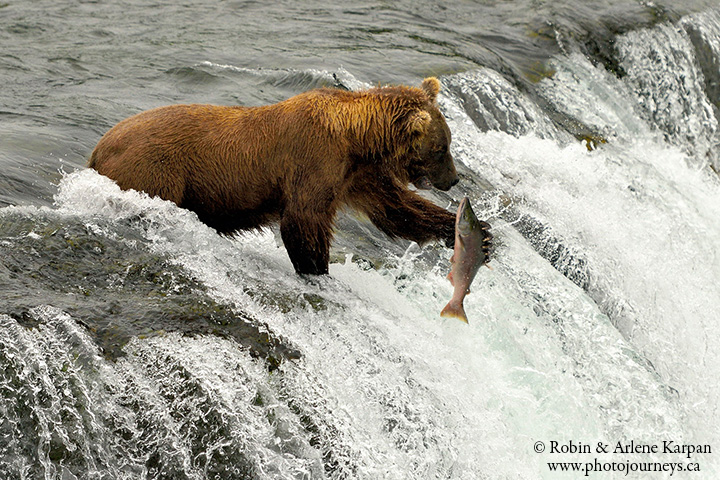
Ways to Visit
There are three main ways to visit – staying at Brooks Lodge, staying at the nearby national park campground, or flying in for a day trip from a few different places in Alaska. For us, the campground was the obvious choice. The lodge is crazy expensive and gets booked up far in advance, while a day trip doesn’t allow much time. The campground costs $12 per person per night – an incredible bargain considering where you are. The glitch is that campground capacity is limited to 60 people, and everyone wants to go in mid-July. Reservations for the season open on January 5 (for 2016, it opens at 8:00 am Alaska Time Zone) on http://www.recreation.gov, which handles reservations for US national parks. Prime dates go almost instantly, so if you want your selected dates, be ready to book the minute the reservations go live. That means setting up an account in advance and becoming familiar with how the website works.
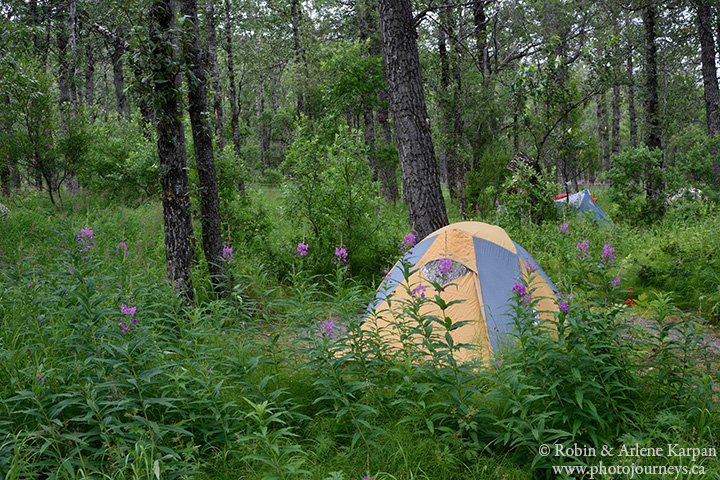
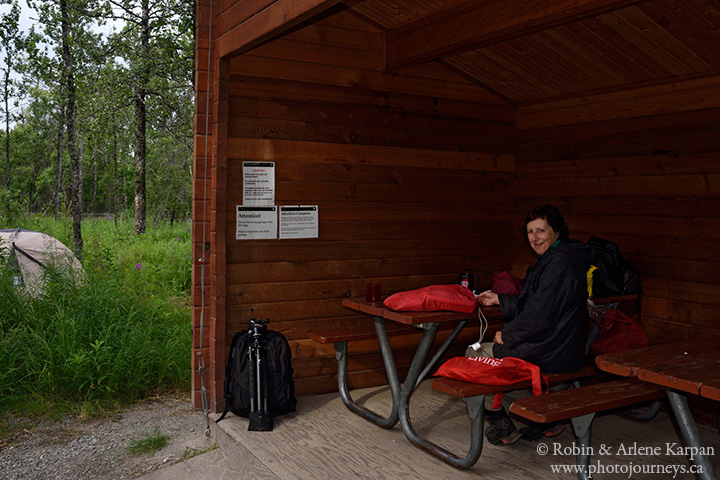
The campground is basic, with no electricity, but more than adequate. There are two toilets and one cold water tap. If you want a shower, you can pay for one at the lodge. There are three shelters with picnic tables so you have somewhere to go to cook and eat your meals in Katmai’s frequently rainy weather. One building is a food cache to store your food, and another building is to store excess gear. We brought and cooked all of our own food, although there’s also the option of eating meals (quite pricey) at the lodge. You can bring a camp stove, but not fuel (airlines frown on that sort of thing). Fortunately, you can buy fuel, including isobutane canisters, at the small camp shop. If you’re wondering what to do during the cool, sometimes rainy evenings, campers are welcome to hang out around the huge fireplace in the lodge common room, or you can make a fire in one of the campground firepits.
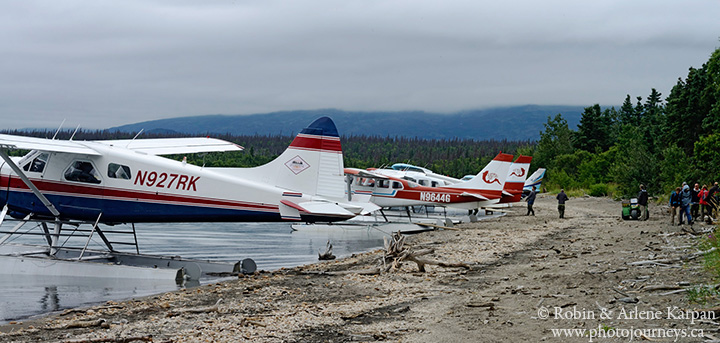
Getting There
The closest place with regular scheduled air service is King Salmon, on the edge of the park. From here it’s a 20-minute float plane flight to Brooks Camp. Last season, the cost for the float plane was US $206 return per person on Katmai Air (http://www.katmailand.com). You are allowed 50 pounds of luggage per person, and this includes your carry-on. Over that weight, you have to pay extra. We managed to keep our weight to 50 pounds each, which took careful planning considering that this included our camping and cooking gear, all food for four days, plus camera gear (which alone was close to a third of the weight).
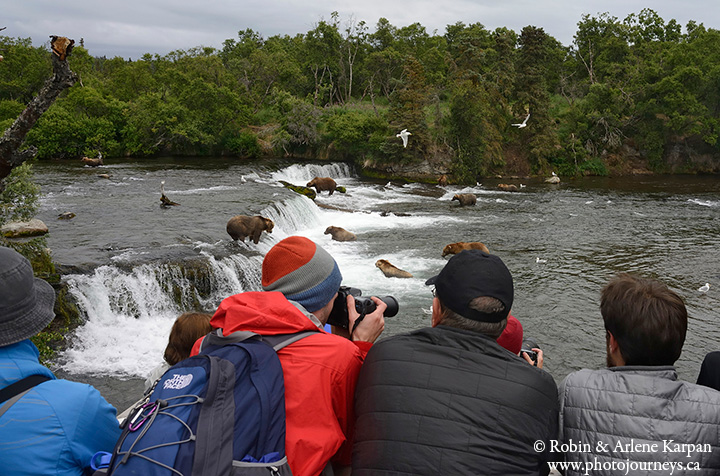
Flights to King Salmon can be pricey. If you have a frequent flyer plan with Alaska Airlines, this is the place to use it. Well in advance of our trip, we each signed up for VISA credit cards linked to Alaska Airlines. As a welcome bonus for signing up, we got 25,000 points on Alaska Airlines Mileage Plan – enough for a return trip within North America, including to King Salmon. To get the flights we wanted, we booked close to a year ahead. This option is only useful if you’re reasonably close to an Alaska Airlines gateway. For us, the closest airport with Alaska Airlines service is Edmonton, about a six hour drive away, which is not too bad. Even with taxes and baggage fees, it turned out to be a fairly inexpensive trip. But even if we had to pay for flights to King Salmon, it would have been worth it. Seeing and having the opportunity to photograph the bears is simply priceless.
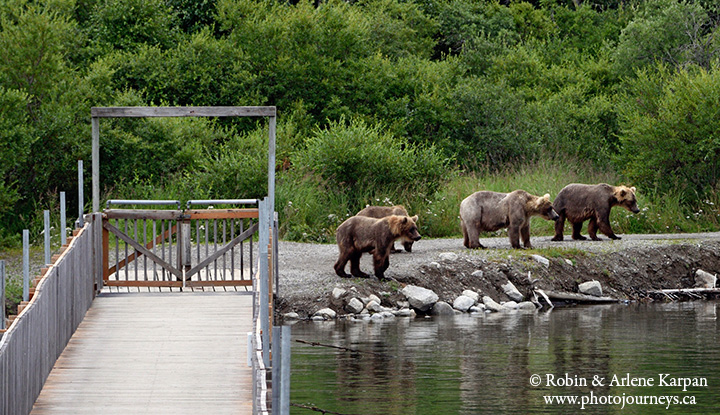
Day trips
What about visiting on a day trip? A lot of people do this, although it is not something we would recommend unless you have no other choice or if you are happy with a brief look at the bears. Time with the bears will be short, even if everything goes smoothly, and there is a lot that could go wrong. On arrival at Brooks Camp, everyone has to go through a brief orientation (“bear school”) with a park ranger, then it’s about a 2-km walk to the falls. Along the way you have to cross a pedestrian bridge at the river mouth, where there are frequent “bear jams”. When bears come too close to the bridge, which they often do, rangers will close the bridge until the bears decide to move on. One time during our visit, the bridge was closed for 2 1/2 hours. When you get to the falls, there is limited capacity on the main viewing platform and visitors are restricted to one hour at a time during busy times, which is pretty much all the time that day trippers are there. Then you have to walk back and hope that you don’t get held up by another bear jam before your flight leaves. Katmai gets a lot of rainy, overcast, and unpredictable summer weather, which could complicate things further, both for your time at the falls and schedules for float planes. We’re not saying that you shouldn’t take a day trip; just be aware of the potential glitches that could arise.
During our four-day stay, we didn’t worry as much about the frequent bear jams, or when it rained heavily, because we knew that we could return to the falls again. Best of all, the viewing platform was never crowded in the evening after the day trippers were gone, and we could stay as long as we wanted.


Loved reading your post! I’ve been there before but at the lodge. Camping sounds like a good alternative. One question, though: with no electricity, how did you keep your equipment charged? Thanks!
Thanks for your comments Valerie. We were wondering the same thing before our visit, so we took enough extra camera batteries to last. However, a lot of campers would charge their batteries at wall plug-ins in the common room of the lodge.